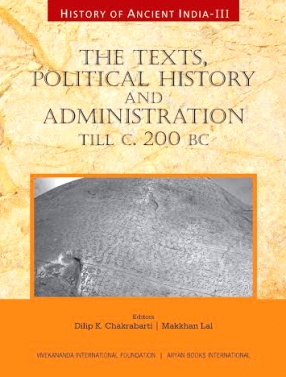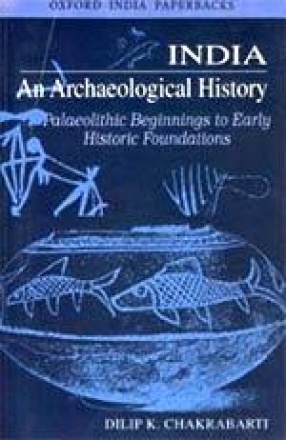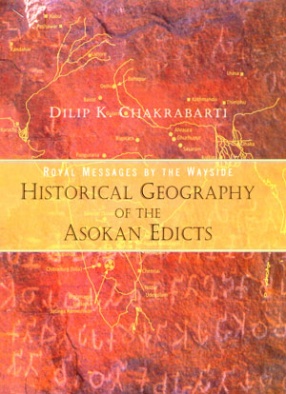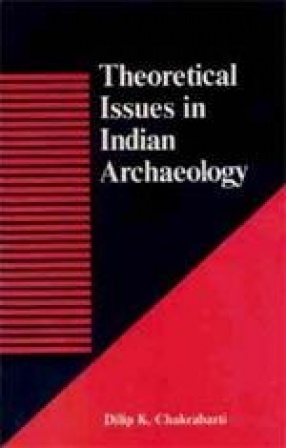
Dilip K Chakrabarti

31 books












This volume has sought to examine the basic elements of geographical, historical, economic and religious interactions between the accepted outer boundary line of the Indian subcontinent and the major geographical zones which lie outside it. The various boundary lines, which were drawn from time to time in the late nineteenth and early twentieth centuries to define the sub-continent in relation to its overland neighbours, were the products of the contemporary ...

The book explores various ground realities of the ancient historical and archaeological research in India through some essays and reviews. These realities turn out to be harsh and often demeaning to the nation, but the Indian archaeologists and ancient historians, if they want to serve the nation in any way, should be mindful of this harsh present and play their own parts in changing the situation. These essays and reviews have been mostly published in various ...

Vivekananda International Foundation (VIF) is a non-partisan think-tank of strategic and security affairs. Its guiding principle is "Nation First". Some of the country's leading experts in the fields of security, armed forces, diplomacy, governance and academia have got together under its aegis to generate ideas and stimulate action for greater national security and prosperity. It works under the guidance of a registered trust with eminent people in ...

It is important to reassess, formulate and develop India's civilizational and cultural imperatives in an increasingly globalised world. The nation’s perception of its ancient history plays a major role in this. The present series on the history of ancient India was conceived with this in mind. The aim is to put forward a nationalistic, factual and objective history of the ancient Indian past in eleven volumes. The cobwebs of certain ideas that we have lived ...

It is important to reassess, formulate and develop India's civilizational and cultural imperatives in an increasingly globalised world. The nation’s perception of its ancient history plays a major role in this. The present series on the history of ancient India was conceived with this in mind. The aim is to put forward a nationalistic, factual and objective history of the ancient Indian past in eleven volumes. The cobwebs of certain ideas that we have lived ...

It is important to reassess, formulate and develop India's civilizational and cultural imperatives in an increasingly globalised world. The nation’s perception of its ancient history plays a major role in this. The present series on the history of ancient India was conceived with this in mind. The aim is to put forward a nationalistic, factual and objective history of the ancient Indian past in eleven volumes. The cobwebs of certain ideas that we have lived ...

It is important to reassess, formulate and develop India's civilizational and cultural imperatives in an increasingly globalised world. The nation’s perception of its ancient history plays a major role in this. The present series on the history of ancient India was conceived with this in mind. The aim is to put forward a nationalistic, factual and objective history of the ancient Indian past in eleven volumes. The cobwebs of certain ideas that we have lived ...

It is important to reassess, formulate and develop India's civilizational and cultural imperatives in an increasingly globalised world. The nation’s perception of its ancient history plays a major role in this. The present series on the history of ancient India was conceived with this in mind. The aim is to put forward a nationalistic, factual and objective history of the ancient Indian past in eleven volumes. The cobwebs of certain ideas that we have lived ...

The present volume may be judged on two levels. On the first level, it deals with the beginning and the current status of archaeology in the Indian university system, focussing primarily on the author's own experience as a long-standing teacher of the subject. It also outlines the author's personal background and early academic roots, hoping to give an idea of the types of students who were drawn to archaeology in India in its early phase. There are also notes on ...

This book discusses the geographical implications of the locations of the Asokan edicts and is based on field-studies of many of these locations. The Asokan studies have largely been based, since their inception, on the issues of language, script and grammar, and one hopes that the studies of this kind, which are important ingredients of Asokan scholarship, will continue to be undertaken. However, textual scholarship or grammatical rules do not necessarily lead ...

How did different parts of the Indian subcontinent interact through out its ancient history? This book presents a new approach for understanding the political history of ancient India. It underlines how politics was enacted in various geographical orbits that kept interacting throughout the period without any fixed boundary or ‘divide’. Dilip Chakrabarti closely examines the focal geographical points along which ancient Indian dynasties tried to ...

Rooted in an earlier field-study (1999-2002) of the routes which linked the Ganga plain with the Deccan, this volume, based on a subsequent field study (2004-2006), studies on the ground the network of routes which linked the Konkan coast and its Maharashtra and Karnataka hinterland with a vast region from the mouth of the Godavari to the tip of the southern peninsula. Among other things, it shows the main historical and geographical linkage between the various ...


An increased pace in archaeological research in recent decades has yielded a construction of the history of prehistoric and early historic India primarily in terms of archaeology. This book narrates the flow of India’s grassroots archaeological history from the palaeolithic beginnings to c. AD 300, when early historic India assumed its basic form. Being the only ‘current’ introductory text on Indian archaeology, it incorporates the latest research in the ...

This book discusses the ancient historical geography of the lower and middle sections of the Ganga plain. Its basis is a field-study of the distribution of archaeological sites in the region. The geographical issues which have been considered here are the location of sites, the historical linkages of different areas, the problems of political geography, and the routes. The work follows the author’s earlier archaeological studies of the Chhotanagpur ...

This book offers an authoritative historical frame of archaeological research in post-Independence India. It outlines the early evolution of the new India’s archaeological policy and the wide range of discoveries which accompanied it. It shows how in the first flush of Independence archaeological research added new depths and dimensions to the ancient Indian past. It also looks closely at the tangled web of ideas behind this research, ...

The aim of the fieldwork, on which this book is based, was to explore the possibility of conducting archaeological excavations in Surat where the Europeans including the British were most likely to have left behind the material traces of their presence between 16th and 18th centuries. However, before undertaking such excavations, one should have an understanding of the historical framework within which the relevant archaeological issues can be contextualized. The ...

This volume, the third and final part of A Source-book of Indian Archaeology, takes one to the tentative beginnings of Indian sculptural, architectural, numismatic and inscriptional studies and tries to give an idea of what has been generally achieved in the fields of human skeletal discoveries, rock-art and religion. The articles chosen for the first section will give a feel of how it all began: how were some of the classical sculptural and architectural sites ...

This book was first published in 1992. It is still the only authoritative and comprehensive review of Bangladesh archaeology in the context of the archaeology of the subcontinent. The present print bears an update on the more recent developments in the field. In the context of South Asian archaeology as a whole, the archaeology of Bangladesh is viewed with general indifference. The iconographic, sculptural, architectural, epigraphic and numismatic data from this ...

Archaeology is a neglected field of study in eastern India. However, the area from Arunachal to Orissa and Bihar covers a very large chunk of the subcontinent and is also along its most distinctive cultural areas. From this point of view the establishment of a new archaeological research institute, Centre for Archaeological Studies and Training, in Calcutta by the Directorate of Archaeology and Museums, Government of Bengal, is a welcome development. In September ...

More than 5,000 years ago, India’s first civilization flourished with well-planned cities, civic amenities, and a developed economy. Since the first discovery of this civilization in 1920-21 at Harappa in the Indus valley, hundreds of sites spread over more than a million square kilometers in the Indian subcontinent have been excavated, many of these in northern and western India. Sites are still being discovered constantly adding to our knowledge of this ...

This is the first of a projected three volumes. It has been compiled with two aims: (1) to indicate the development of archaeological research in India and the emergence of a specifically "Indian" approach to archaeology and prehistory; (2) and to provide a source-book for students both in India and outside, which will give a selection and excerpts from the significant writings on Indian archaeology to date. As many of the articles are from widely ...

The theoretical issues which have been considered in the present volume are the changing perspectives in Indian archaeology, diffusion an explanatory model, archaeology-literature correlation, geographical approaches, the study of prehistory, transition to foodproduction and urbanisation, agriculture, metallurgy and trade. The author's discussion of these issues (done in a course of eight seminars under the auspices of Ecole des Hautes Etudes en Sciences ...
